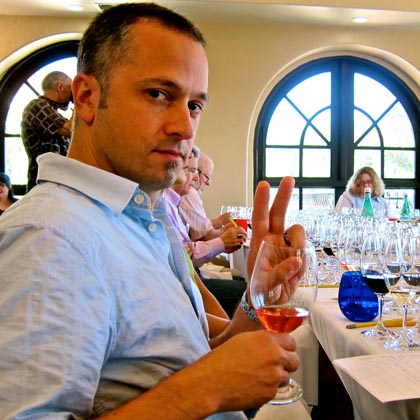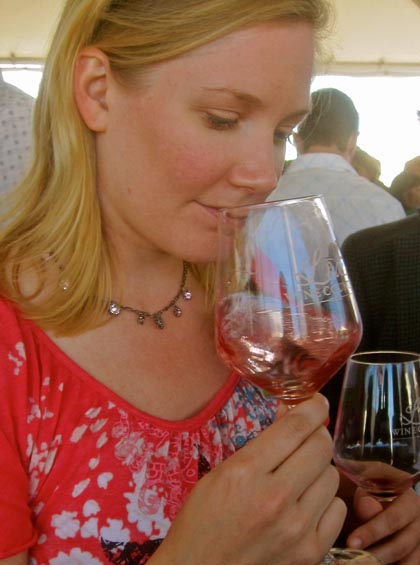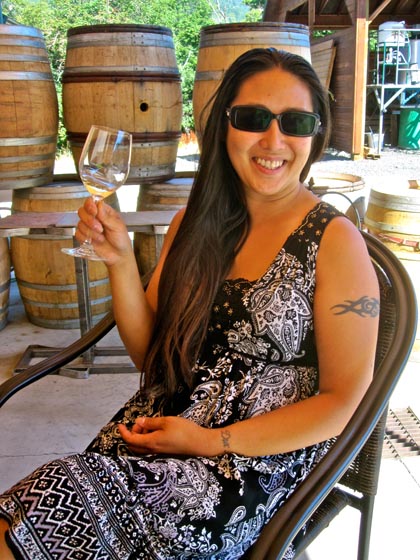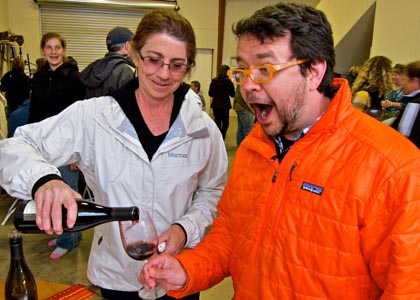Letters from Lodi
An insightful and objective look at viticulture and winemaking from the Lodi
Appellation and the growers and vintners behind these crafts. Told from the
perspective of multi-award winning wine journalist, Randy Caparoso.
Wine 101: tasting & talking
1winedude.com's Joe Roberts at the tasting table
How to taste wine, without the gobbledygook…
‘Tis a far, far easier thing to do than what it’s been made out to be. Tasting wine is just like tasting food, except it involves a liquid in a glass, and getting accustomed to a process involving
- Seeing
- Swirling
- Smelling
- Sipping
As Yogi Berra might have said, you can see a lot by looking, and it’s as important to first look at a wine as it is to first look at a dish before you eat it because our sense of smell and taste are most definitely connected to our visual sense. If you see a hamburger, you expect something meaty and drippy, and maybe a little crunchy if there’s a fresh leaf of lettuce and sliced tomato in it. If you see a white wine, you expect something cool and refreshing. Reds get your senses ready for something dryer and meatier. Sparkling wines, usually tart and lively, make your feet want to dance along with the sensations on your palate.
Then you begin the process of tasting, which you start by swirling. Swirling wine in a glass is not an affectation. The reason you swirl is to allow it fall down the sides and create the vapors that you smell and perceive as aromas. This is why good wine glasses are usually clear, tulip shaped, come with a stem, and best poured to only a third full at a time – to contain the vapors and keep you from spilling as you swirl.
Start by holding your glass by the stem (always hold wine glasses by the stem, not the bowl), and gently twirl in circular motion. If this feels awkward, move your glass around in a little circle as it sits on the table.
Then you smell. As you bring your nose to the rim of the glass, open your mind up to what it reminds you of. Chardonnays, as we mentioned before, are usually reminiscent of apples, and Cabernet Sauvignons of dark fruits like blackcurrant and berries, often with a little bit of mint or eucalyptus. Zinfandels have that blackberry, raspberry or cherry-like aroma with a “jammy” intensity, and often a backdrop of spice (usually liked cracked black pepper, although sometimes like cinnamon and/or clove). The idea is that if you can’t smell wine then you really can’t taste it, since flavor is related directly to smell.
Finally you actually sip, which for wine entails discovering how the natural elements of alcohol, acidity, and (for red wine) tannin come together with the aromas to create a pleasant (hopefully!) flavor as it sits on the tongue just before it is swallowed.
In respect to a wine’s feel on the palate, alcohol gives wine its “body,” which is a good word to use when describing whether a wine is light, heavy, or somewhere in-between. German whites made from the Riesling grape and Italian style Moscato tend to be less than 10% alcohol, and thus are very light and easy to drink. California and French white wines made from Chardonnay tend to fall in the 13%, 14% alcohol range, and thus are usually described as full bodied, thick, or even heavy. Most Sauvignon Blancs are around 12%, 13% alcohol, and so are usually medium bodied – neither light nor heavy.
Red wines such as Cabernet Sauvignon, Merlot, Zinfandel, Syrah and Petite Sirah usually have full alcohol (13%, 14% or more) as well as generous levels of tannin, further accentuating the feel of body. Although a wine made from the Pinot Noir grape can be just as high in alcohol, they may very well taste lighter or softer in body simply because they are typically lower in tannin than wines made from Cabernet Sauvignon and Merlot.
Finally, you do make a quality assessment. Did you enjoy the look, the aroma and the taste, or was it so-so? Many people can’t abide by dry wines, which they find bitter or harsh; although most people these days really don’t like wines that are even a little sweet, finding them cloying or annoying. If you have a democratic, or catholic, taste (in the sense of appreciating anything that’s finely made), then what you probably look for more than anything is a sense of balance, or a certain harmony or smoothness of elements, whether the wine is dry or a little sweet, light or full bodied, white or red, pink or bubbley, etc.
And if you truly enjoyed it? Try to remember it, or write it down somewhere. Half the joy of wine is seeking out other enjoyable, which can lead you to other wines made from the same grape, by the same producer, from the same region, or having any other connection.
Hardy "Dirty South" Wallace, seeing red...
All the words you need to know to talk ‘n walk with the best of ’em…
Entire books and magazines, of course, are devoted to the description of wines, and it can be quite complex. In the everyday setting, however, you need only be able to communicate the taste of wine to guests in basically six ways:
Color or appearance – is it still or sparkling… pink, white or red… deep, almost purplish red… or a lighter, brick toned red?
Aroma (i.e. the wine’s “flavor” once it hits the palate) – what does it remind you of… a certain fruit, a spice, flower, or even mineral?
Dryness/sweetness — some degree of sweetness, or none at all?
Body or weight — is it light, full, or just “medium”?
Acidity, for whites and sparklers – is it zesty or tart… or the opposite, soft and round?
Tannin level, for reds – big or hard… light and soft… somewhere in between?
That’s it for now!
Our next Wine 101: the importance of glasses and temperature
Thirsty wine enthusiasts in San Francisco's Fort Ross




